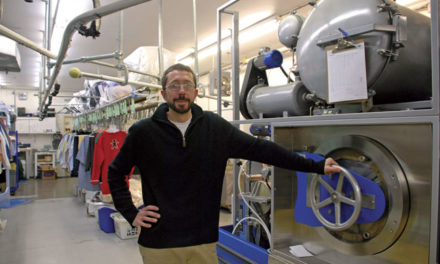BY JASMINE WYLIE
This morning I woke up. I made coffee and carried my cup out to the back porch. At 6 am, it was still dark outside. Off in the distance, through the trees, I saw the IU Health Bloomington Hospital sign in giant, glowing letters. And like every morning, I looked at those glowing letters, and thought, “I am so glad I live in Bloomington.”
This city has a lot of things I appreciate—the university, the great restaurants, the thriving art scene—but none more than that building, rising above the city. I feel such a fondness for IU Health Bloomington Hospital because one morning in 2009, when I was 24 years old, I did not wake up. Instead, I had a sudden cardiac arrest (SCA). My husband, Clint, immediately began CPR, and within minutes I was being whisked by ambulance to the hospital. There, on a hot August morning, I received the coldest gift of my life.
Therapeutic hypothermia is a treatment in which the body temperature is lowered to between 89.6 and 93.2 degrees Fahrenheit in order to preserve neurological function. This treatment is not offered at every hospital, and in 2009 it was rarer than today. I was only the tenth patient cooled at Bloomington Hospital.
The cause of my SCA was Long QT syndrome, a condition I inherited. If your family has a history of sudden death among young, otherwise healthy people, you should check it out. According to the Mayo Clinic website, Long QT syndrome is “a heart rhythm disorder that can potentially cause fast, chaotic heartbeats.” Warning signs include fainting or seizures, especially during exercise or emotional stress. Until my attack, I had no symptoms and the disorder had gone undiagnosed. For about 10 percent of people with the syndrome, cardiac arrest is the first—and often last—symptom.
When Long QT appears in the news, it is often a tragic story: the football player who drops dead in the middle of the homecoming game, the boy who drowns in a swimming pool, the little girl who passes away in her sleep, the woman who dies shortly after the birth of her first child. Thanks to a quick response by my husband, advanced medical technology, and a whole lot of luck, my experience did not turn out to be one of those tragedies. Perhaps that is why I tell my story, as a testament to living with a sudden death syndrome.
Long QT syndrome is treated with medication and/or an implanted cardioverter-defibrillator, a device similar to a pacemaker that can deliver a life-saving shock. I am quite fond of my defibrillator, because 11 months after that August morning in 2009, it fired a shock. But this time, I didn’t need CPR or an ambulance or a cold coma to protect my brain. This time, I just felt a jolt and hopped right up to start the coffee.
There is no cure for Long QT syndrome. It’s part of my genetics and will be with me until the day I die. Now that I am diagnosed and being treated, I’m planning on living to be at least 107. Indeed, those of us who get a diagnosis are the lucky ones.
SCA survival statistics are dismal. It is a leading cause of death, with about 300,000 people in the U.S. losing their lives to SCA each year. About 4,000 of these deaths are due to Long QT syndrome. Less than 10 percent of those who experience an SCA survive, and many of those survivors suffer long-term brain impairment.
For those who survive but do not immediately regain consciousness, the only treatment proven to protect the brain is therapeutic hypothermia. So this morning, like all mornings, I sipped my coffee on the back porch, looking at those glowing letters in the distance, and was grateful that I was taken there and received this treatment.
Some SCA survivors talk about seeing a light when they were stricken. I see lights every morning of my life: giant glowing letters that read, IU Health Bloomington Hospital.








Dropped dead of a cardiac arrest . I was 26. My husband had just stopped home to say goodbye cuz after work I was going on a Canoe trip. He heard a crash and he started CPR. I was without air for over 15 minutes. Put on life support for 2 weeks. Have my 5th defibrillator . I am now 50. Months of speech therapy has helped although unthinking isn’t the same. But I am blessed. No diagnosis after testing at mayo for days. Just called sudden death patient.
I am 51 and had just started working in a clerical capacity at a famous heart hospital in England, when while on a coffee break in the hospital restaurant I had a heart attack. Initially I was unaware that it was a heart attack, I thought that maybe I’d drank the coffee too quickly as I had an ache in the middle of my chest, that was until my arm tingled from fingertip to shoulder and then I felt quite unwell. I called for assistance via a member of he public at the next table who kindly alerted someone in the queue for food. Luckily for me, this someone was a doctor who could see I was having a heart attack. She immediately put a ‘cardiac arrest’ call out and thankfully she did because not long after I went into cardiac arrest and went onto have four rounds of CPR and shock treatment. I had angioplasty in an emergency operation as I had a 100% blockage of the coronary artery.
It was not my day to die that day because various Medics told me that had I been anywhere else, the outcome would not have been the same. For me, this experience has changed my outlook on life. I see all the positives and cherish my family more than ever. I am truly thankful for the care I was given that day, they saved my life.
Angela